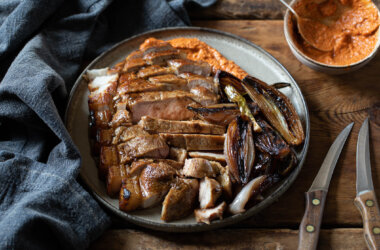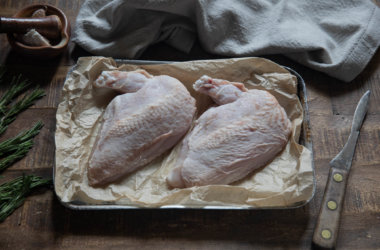
What Is Venison Saddle?
How to Cook Venison Saddle: The venison saddle, taken from the back of the deer and comprising the two loins, is a premium cut prized for its tenderness and rich flavour. Delivered deboned and expertly prepared, Swaledale’s venison saddle is neatly rolled and secured with butcher’s string, ensuring the joint holds together perfectly during cooking.
We recommend roasting your venison saddle low and slow for maximum flavour and juiciness. As one of the leanest and most tender cuts of venison, it’s a refined option for the colder months, delivering deep, satisfying flavour without the heaviness of fattier meats.
A fabulously tasty and tender alternative to the classic Christmas Bronze turkey, slow-roasted saddle of venison is a showstopping centrepiece. Ideal for special occasions or festive celebrations, this dish is perfect for sharing with family and friends.
Venison Saddle Cooking Time
Higher temperatures tend to dry out a venison saddle joint, so the best method for achieving a mouth-watering, medium-rare roast is to quickly brown the outside of the joint in a pan with foaming butter before transferring it to the oven at 160–170°C.
For precision, we always recommend using a meat thermometer. Aim for the venison saddle to reach an internal temperature of 53–54°C after resting to ensure perfect medium-rare results. If you don’t have a meat thermometer, cooking times will vary based on the size of the joint. As a general guide, allow approximately 15 minutes of cooking time per 500g of venison saddle.
How to Cook Venison Saddle
- Preparing the Venison Saddle: Take your venison saddle out of the fridge, remove it from the vacuum packaging, and pat dry any moisture. Allow the meat to come up to room temperature, as this ensures even cooking.
- Preheat the Oven and Prepare the Pan: Preheat your oven to 170ºC/Fan 150ºC/Gas 3. Heat a heavy-based frying pan on the hob until it starts to smoke lightly.
- Season and Brown the Saddle: Rub the venison saddle with olive oil and season generously with coarse sea salt and cracked black pepper. Place the saddle in the hot pan and begin browning the meat, keeping it moving around the pan and rotating it to seal all sides evenly.
- Baste with Butter: Once sealed on all sides, add a knob of butter to the pan. Reduce the heat slightly and baste the saddle in the foaming butter, rotating and basting continuously to coat all sides thoroughly.
- Roast the Saddle: Carefully transfer the venison saddle to a roasting tin and place it in the preheated oven. Set a timer for 10 minutes.
- Baste Midway Through Cooking: After 10 minutes, remove the saddle from the oven and baste it again with the pan juices before returning it to the oven for another 10 minutes.
- Check Temperature and Finish Cooking: Continue roasting for a total of 20–25 minutes, or until the internal temperature of the saddle reaches 48–50°C for rare to medium-rare.
- Rest the Saddle: Remove the venison saddle from the oven and let it rest in a warm place for at least 20 minutes. Resting allows the juices to redistribute, ensuring tender and flavourful meat.
This method ensures a perfectly cooked venison saddle with a caramelised exterior and tender, juicy interior.
Top Tips:
- Season with Bold Flavours: An interesting seasoning option is to crush black pepper, juniper berries, a little picked rosemary, and sea salt in a pestle and mortar. Rub this fragrant mixture generously over the venison saddle before cooking to enhance its flavour.
- Make a Rich Gravy: After removing the venison saddle from the oven and allowing it to rest, you can create a rich and delicious gravy using the roasting tin juices. Place the tin over medium heat, stirring to thicken the juices, then strain the gravy into a boat for serving. Drizzle this over your carved venison for a perfect finishing touch.
- Serve Leftovers Cold: Leftover venison saddle is equally delightful when served cold. Take inspiration from Scandinavian flavours by preparing a vibrant salad with sliced venison saddle, crispy onions, redcurrants, pickled fennel, and dill. Dress with a drizzle of oil and a sprinkle of sea salt for a dish that offers an exciting mix of flavours and textures in every bite.
- Transform into a Shepherd’s Pie: Alternatively, transform the cold meat into a luxurious take on shepherd’s pie. Use the venison to create a rich, gamey filling topped with creamy mashed potatoes for a truly indulgent twist on a classic comfort food.
How to Carve Venison Saddle:
- Carve your venison saddle widthways into thin, even slices to ensure each piece is tender and easy to serve. Use a sharp carving knife and steady strokes for clean cuts. Plan for approximately 200g of meat per person, adjusting slightly based on appetite or serving size.
- For presentation, arrange the slices on a warm platter, slightly overlapping, and drizzle with any reserved gravy or pan juices for added flavour. This method not only enhances the visual appeal but also keeps the meat moist and delicious.
Roast Venison Saddle Recipe:
This stunning Roast Venison Saddle Recipe by George Ryle showcases tender, flavourful venison loin, expertly paired with the rich, hearty taste of red wine-braised lentils, caramelised radicchio, and the tangy bite of pickled walnuts. A true celebration of winter’s finest ingredients, this dish combines the bold, earthy flavours of game meat with vibrant accompaniments, creating a show-stopping centrepiece for festive feasts or special occasions. Whether you’re hosting a dinner party or looking for a unique alternative to a traditional roast, this venison saddle recipe is a must-try for showcasing the beauty of heritage meat.












